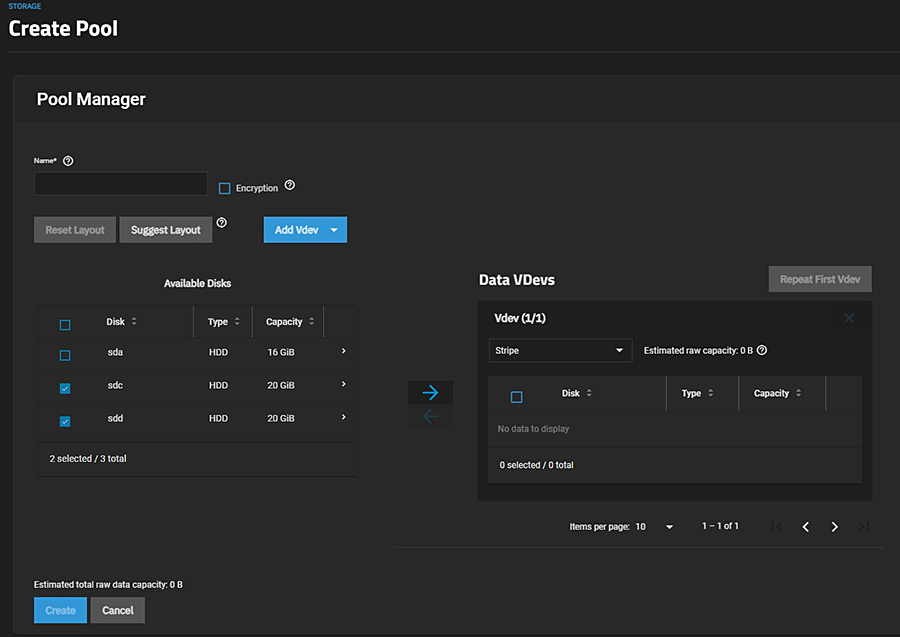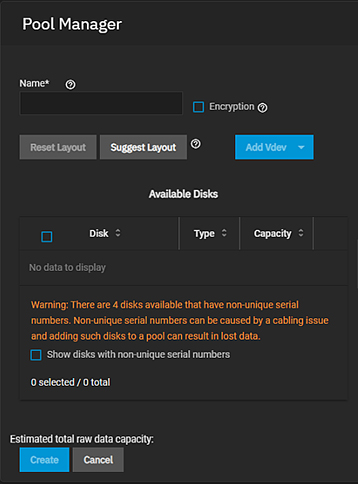TrueNAS SCALE Documentation Archive
This content follows the TrueNAS SCALE 22.12 (Bluefin) releases. Archival documentation is provided for reference only and not actively maintained.
Use the Product and Version selectors above to view content specific to different TrueNAS software or major versions.
Pool Manager Screen
5 minute read.
Last Modified 2023-08-31 14:46 EDTThe Storage Dashboard displays information about the pools configured on your TrueNAS system. To create a pool, click the Create Pool button at the top right of the screen. The Pool Manager screen displays:

| Name | Description |
|---|---|
| Name | Enter a name for the pool of up to 50 characters in length that follows ZFS naming conventions. Pool names should be lower-case alpha characters to avoid potential problems with sharing protocols. Names can include numbers, and special characters such as underscore (_), hyphen (-), colon (:), or a period (.). |
| Encryption | Select to enable ZFS encryption for this pool, the root (parent) dataset and if desired, child datasets and zvols in this pool. See Storage Encryption for more information on using SCALE storage encryption. |
| Reset Layout | Click to reset the proposed layout displayed. Click before you save to remove any VDEV types selected and move disks assigned to any VDEV back to the Available Disks list. |
| Suggest Layout | Click to allow TrueNAS to review all available disks and populate the primary data VDEVs with identically sized drives. These drives are balanced for storage capacity and data redundancy. To clear the suggestion, click Reset Layout |
| Add Vdev | Click to display the dropdown list of VDEV options. VDEV types are Data, Cache, Log, Hot Spare, Metadata or Dedup. Click to add VDEV types to an existing or new pool VDEV setup. |
| Available Disks | List of available disks on the TrueNAS. Click the expand icon to see the disk serial number and model number. Select the checkbox to the left of the disk and then select the blue to the right of the VDEV type (if more than one VDEV type exists or is added with the ADD VDEV button) to move the disks to that VDEV. To move it back to the Available Disks list, select the disk checkbox(es) and the blue . |
| Data VDevs | List of disks assigned to the VDEV(s). You must include a Data VDEV in any pool you create and before you add any other type of VDEV to the pool. To move disks back to the Available Disks list, select the disk checkbox(es) and the blue symbol. |
| VDev type | Displays under the Data VDevs heading. For an existing pool, the default VDEV type is the VDEV type for that existing pool. For initial pool creation, the default type is Stripe. After adding disks to the Data VDevs a expand symbol displays with available options to change the default type of VDEV (for example, if two disks are moved to a Data VDEV, the Mirror option displays along with Stripe). |
| Estimated raw capacity: | Displays the raw storage capacity of the disks for the Data VDEV type. |
| Estimated total raw capacity: | Displays the estimated total raw capacity of the disks in the VDEV. |
Use CANCEL to exit without saving and display the Pools screen.
Use CREATE to add the pool VDEV.
If your system disks do not have unique serial numbers, the Pool Manager screen displays a warning message and the Show disks with non-unique serial numbers option.

Select Show disks with non-unique serial numbers to display the system disks.
The 0 selected/ # total below the Available Disks displays a count of the number of disks selected / to the total number of disks available on your system. This counter keeps track of the total number of available disks in the system when disks span across several screen pages.
| Settings | Description |
|---|---|
| Data | Data is the standard VDEV for primary storage operations. Each storage pool requires at least one data VDEV. Data VDEV configuration typically affects how users can configure other types of VDEVs. |
| Cache | A cache VDEV is a ZFS L2ARC read-cache used with fast devices to accelerate read operations. Users can add or remove cache VDEVs after creating the pool. |
| Log | A log VDEV is a ZFS LOG device that improves synchronous write speeds. Users can add or remove log VDEVs after creating the pool. |
| Hot Spare | A Hot Spare VDEV is a drive or drives reserved for inserting into Data VDEVs when an active drive fails. The system uses hot spares as temporary replacements for failed drives to prevent larger pool and data loss scenarios. When a user replaces a failed drive with a new one, the hot spare reverts to an inactive state and becomes available again as a hot spare. If a user detaches the failed drive from the pool without adding a new one, the system promotes the temporary hot spare to a full Data VDEV member. |
| Metadata | A Metadata VDEV is a special allocation class used to create fusion pools for increased metadata and small block I/O performance. |
| Dedup | A Dedup VDEV stores ZFS de-duplication. Requires allocating X GiB for every X TiB of general storage. Example: 1 GiB of Dedup VDEV capacity for every 1 TiB of Data VDEV availability. |
| Settings | Description |
|---|---|
| Stripe | Each disk stores data. A stripe requires at least one disk and has no data redundancy. |
| Mirror | Data is identical in each disk. A mirror requires at least two disks, provides the most redundancy, and has the least capacity. |
| RAIDZ1 | Uses one disk for parity while all other disks store data. RAIDZ1 requires at least three disks. |
| RAIDZ2 | Uses two disks for parity while all other disks store data. RAIDZ2 requires at least four disks. |
| RAIDZ3 | Uses three disks for parity while all other disks store data. RAIDZ3 requires at least five disks. |
Related Content
- Creating Storage Pools
- Disks Screens
- Managing Advanced Settings
- Importing a Pool
- Advanced Settings Screen
- Fusion Pools
- Pool
- Storage Dashboard Screen
- SLOG Over-Provisioning

